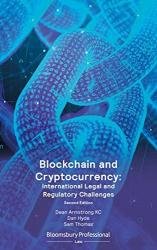Blockchain and Cryptocurrency: International Legal and Regulatory Challenges, 2nd Edition
- Добавил: literator
- Дата: 15-12-2022, 23:07
- Комментариев: 0
 Название: Blockchain and Cryptocurrency: International Legal and Regulatory Challenges, 2nd Edition
Название: Blockchain and Cryptocurrency: International Legal and Regulatory Challenges, 2nd EditionАвтор: Dean Armstrong KC, Dan Hyde, Sam Thomas
Издательство: Bloomsbury Professional
Год: 2022
Страниц: 457
Язык: английский
Формат: pdf (true), epub
Размер: 10.67 MB
The importance of blockchain and cryptocurrencies continually evolving. The first book on this increasingly important topic, it is a pioneering and seminal read which aims to identify regulatory gaps and establish the first applicable legal framework.
Blockchain is one type of distributed ledger technology and, by some distance, the best known. Distributed ledger technology (‘DLT’) ‘is a type of technology that enables sharing and updating of records in a distributed and decentralised way. Participants can securely propose, validate and record updates to a synchronised ledger (a form of database), that is distributed across the participants. As the underlying technology for cryptocurrency it has become synonymous with Bitcoin and is a buzzword that is casually thrown around but often misused and misunderstood. There is no single, universal definition of blockchain and it need not have an associated cryptocurrency. There has been academic debate around the terminology of blockchain and support for the view that blockchain vocabulary is so treacherous because it is a fluctuating, evolving inter-disciplinary technology that is hard to pin down. The terms of reference have also become contaminated from businesses’ attempts to use language that attracts investment. Changes in the language around blockchain technology are largely due to a mix of substantive reasons (such as an actual technological difference) and non-substantive reasons (such as the marketing goals of businesses). It also ‘takes time for people to figure out how to talk consistently about a new topic, and many times, we never do’.
The use of blockchain, however, is not limited to the underlying technology that facilitates cryptocurrency transactions. Blockchain can be used for far more purposes, ranging from registering intellectual property to voting. Its increasing prevalence in a wide range of industries across the world, and its seemingly non-exhaustive list of uses, means that states and authorities must continue to adapt regulatory frameworks in order to ensure that DLTs are used in a safe, consistent and transparent way.
The Internet of Things is to be found in Chapter 8 where our examination includes an explanation of what the Internet of Things (‘IoT’) actually is, the security problems that surround it, how these might be mitigated, and a consideration of who owns the data and the regulation that might apply. The IoT is a network of physical devices that are able to exchange data. At its most basic, IoT devices permit remote monitoring or control of previously ‘dumb’ devices, for example turning your house lights on and off with your mobile telephone. IoT devices may also contain a sensor that can be programmed to detect data inputs, whether it is physical movement, atmospheric circumstances or biometric information. Today virtually every home has a gas or electricity meter and the IoT version of this is the ‘Smart Meter’ which, by design, can gather data for the more efficient distribution of gas and electricity. And this is just one example of an IoT sensor device in our homes; an entire range of usual everyday devices are now fitted with sensors. These sensors can be linked to a variety of devices such as a mobile phone app or computer to measure heart rate, body mass index, body fat percentage or worn on wrists or ankles to measure steps from distances walked and provide a plethora of metrics and feedback. Over the next few years there will be increased connectivity between all areas of human habitation from home to car to hotel to each and every point of existence so that we create a vast interconnected web. The IoT will be a whole new frontier where the advantages intrinsic to the interconnectivity of the IoT devices can be exploited.
Essential reading for commercial practitioners, IT and IP practicioners, financial regulatory practitioners, corporate/white collar crime practitioners, property practitioners, in-house counsel, practitioners in private practice, particularly those who advise entrepreneurs, and corporate and individual investors.
Скачать Blockchain and Cryptocurrency: International Legal and Regulatory Challenges, 2nd Edition
Внимание
Уважаемый посетитель, Вы зашли на сайт как незарегистрированный пользователь.
Мы рекомендуем Вам зарегистрироваться либо войти на сайт под своим именем.
Уважаемый посетитель, Вы зашли на сайт как незарегистрированный пользователь.
Мы рекомендуем Вам зарегистрироваться либо войти на сайт под своим именем.
Информация
Посетители, находящиеся в группе Гости, не могут оставлять комментарии к данной публикации.
Посетители, находящиеся в группе Гости, не могут оставлять комментарии к данной публикации.
